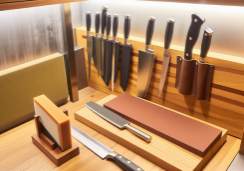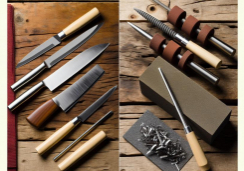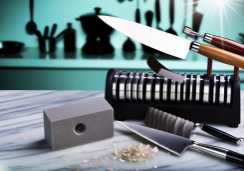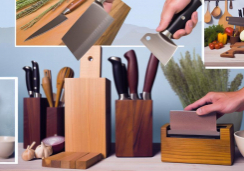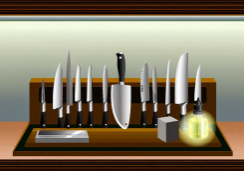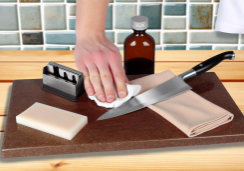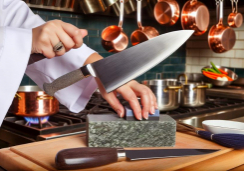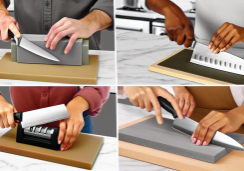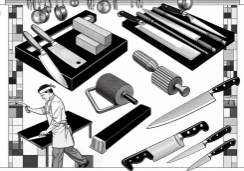3 Best DIY Knife Sharpening Techniques for Home
Just as a master chef carefully selects the finest ingredients for their signature dish, you too must choose the best method to keep your kitchen knives razor-sharp. You're the craftsman in the kitchen, and a dull blade simply won't do when precision and ease are on the line.
Let's explore together the three best DIY knife sharpening techniques that you can employ right at home. From the traditional whetstone sharpening basics to the quick and reliable honing with a steel rod, and even an alternative method using sandpaper, you'll find there is a skill set to be honed that matches your culinary style.
But what makes these methods stand out among the rest, and how can you ensure that your blades are not only sharp but also maintained properly for longevity? Stay with me, as I unveil the secrets to achieving that satisfyingly sharp edge that will make slicing through a ripe tomato feel like cutting through butter.
Whetstone Sharpening Basics
To achieve a razor-sharp edge on your knife, begin by selecting the appropriate grit of whetstone for the condition of your blade. If your knife is dull or damaged, start with a coarse grit, around 400 to 800. For regular maintenance or a blade that's still fairly sharp, a medium grit, such as 1000 to 1500, is ideal. For polishing and refining the edge, finish with a fine grit of 3000 or higher.
Ensure your whetstone is flat; an uneven surface won't sharpen properly. Secure the stone on a non-slip base to maintain stability. Soak or lubricate the stone according to the manufacturer's instructions—some require water, others oil.
Hold the knife at a consistent angle, generally between 15 to 20 degrees for most kitchen knives. Apply moderate pressure and glide the blade across the stone in smooth, even strokes, covering the entire length of the edge. Alternate sides to sharpen evenly.
Honing With a Steel Rod
Have you ever wondered how professional chefs keep their knives in peak condition between sharpenings? The secret's honing with a steel rod, an essential technique that realigns the edge of the blade, maintaining its sharpness.
You don't need to wait until your knife is dull to use a steel rod; in fact, you should hone your knife regularly.
Here's how you do it:
- Hold the steel vertically with its tip resting on a non-slip surface.
- With your dominant hand, grasp the knife by the handle and place the heel of the blade against the top of the steel at a 15-20 degree angle.
- Apply light pressure and glide the blade down the rod, pulling the knife towards you while simultaneously moving it downwards.
- The entire length of the blade should sweep across the steel.
- Repeat this motion 5 to 10 times on each side of the blade.
Alternative: Sandpaper Method
While honing with a steel rod is effective for maintaining an edge, sharpening with sandpaper offers a cost-effective alternative to refine your blade's sharpness further. This method, known as the 'sandpaper method,' utilizes the abrasive qualities of sandpaper to methodically grind the edge of your knife to a razor-sharp finish.
Here's how to do it:
- Choose Your Grits: Start with coarser grit sandpaper and progress to finer grits. A sequence of 400, 800, and 1,200 grit will suffice for most knives.
- Secure the Sandpaper: Lay your chosen sandpaper on a flat surface. To prevent slipping, you can place it on a mouse pad or a piece of wood.
- Establish the Angle: Hold the knife at the correct angle for your blade. A general guideline is about 20 degrees for most kitchen knives.
- Use Even Strokes: Slide the blade across the sandpaper in smooth, even strokes, alternating sides to sharpen evenly. Count the strokes to ensure consistency.
What are the differences between DIY and professional chef knife sharpening techniques?
DIY chef knife sharpening methods often involve using handheld sharpeners or whetstones, while professional chefs may use specialized sharpening tools or seek out professional knife sharpening services. While DIY methods are cost-effective and accessible, professional techniques often result in a more precise and long-lasting edge.
Conclusion
You've now mastered three efficient DIY knife sharpening techniques. Whether you've chosen the traditional whetstone, maintained your edge with a steel rod, or opted for the flexibility of sandpaper, your blades will be keen and ready for any task.
Remember, consistent angle and pressure are key. Keep practicing, and your sharpening skills will rival those of professional chefs.
Sharp knives aren't just a pleasure to work with but a safety imperative in your kitchen. Keep them honed.

